West Ham United Women have been one of the quieter sides in the WSL this season, not being involved in the relegation scrap between Liverpool Women, Birmingham Women and Bristol City Women, but also not challenging for the European spots at the top of the league either. One player who has had a very impressive season for them is 21-year-old Switzerland forward Alisha Lehmann. This tactical analysis will look at how she creates passing options for her team with her movement, how she works with the front line, and how she is versatile in her playing style, meaning she fits West Ham’s tactics wherever she is asked to play.
Creating space
The first theme of Alisha Lehmann’s game that we will look at in this analysis is how she moves to create space for her team.

Here, we see how Alisha Lehmann, circled, is looking to get forward into the space. She likes to play on the shoulder of the defensive line, as we see in this image. Her instinct is clearly to get forward, not only because that is her position, but we can see in this image how her body position shows she is already looking to run forwards despite her teammates in possession (in the square) not having a clear pass through to her.
This does two things to the opposition’s defence: Liverpool Women in this example. Firstly, they can opt to stay where they are and leave Lehmann offside, but risk the ball being passed whilst she is in line with them, as she is here. The second option is to go with her, with the downside being that they leave the midfield areas open and undefended. However, the fact that Lehmann’s movement forwards puts this doubt in their minds is key, and it is one of the reasons that West Ham clearly rely on her runs in behind and look to build from them.
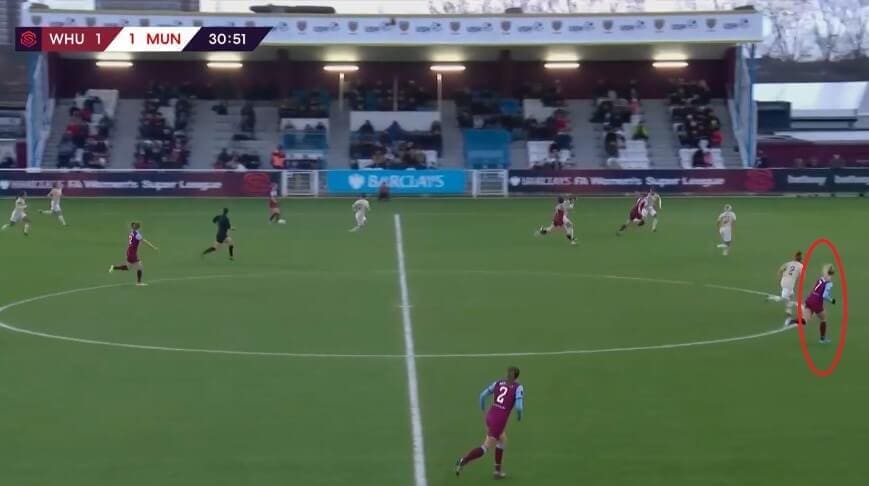
Again, in this example, we see how Lehmann is looking to get in behind the defence. This time, against Manchester United Women, she is on the blindside of the Manchester United defenders, whilst still in line with them. The ball is on the far side of the pitch in this image, so whilst Lehmann would be a difficult player to pass the ball to, she would be the player furthest forward. A pass to her would again stretch the opposition, making it possible that gaps would appear in other areas of the pitch that West Ham could then exploit.
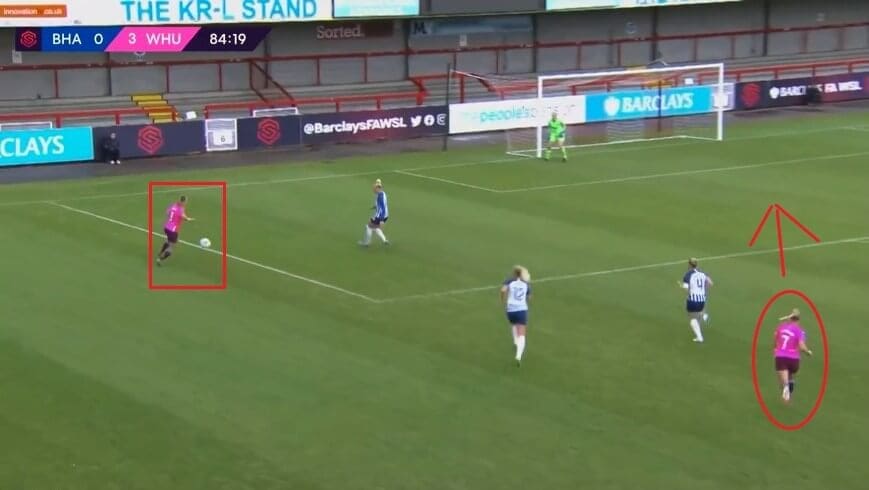
In this example, the ball is on the wing, about to be played into the box. Alisha Lehmann is shown looking to run into the box, and this again comes because she is on the front foot. West Ham need a player in the box, but don’t yet have one. Therefore, Lehmann’s ability to run into these areas is crucial for her team.
The second thing to mention is that Lehmann moves into space for her team to get the ball to her in. We can see this in the image below.

Here, we see how Lehmann has seen where the ball is, and is looking to run ahead of it to help her teammate out. You can see how Reading Women have closed down the West Ham player in possession, and forced her to only play the ball forwards as a result. Therefore, Lehmann’s run is crucial in helping her team keep possession.
You can also see how Reading’s defence is spread out, with large gaps in between the defenders. Therefore, by running forwards to offer the passing option for her teammate, Lehmann has also exploited these gaps, and given West Ham a presence in the space behind the defence. The main reason she is able to do this is because of her pace, and she is very quick when she gets going. This enables her to get beyond the ball and be ready to receive it from her teammates in space.

We can also see this movement forwards in this example. Here, Lehmann has passed the ball from the central to the wide channel, where her teammate is. This ensures that the ball moves from a congested area to open space, helping West Ham to keep possession.
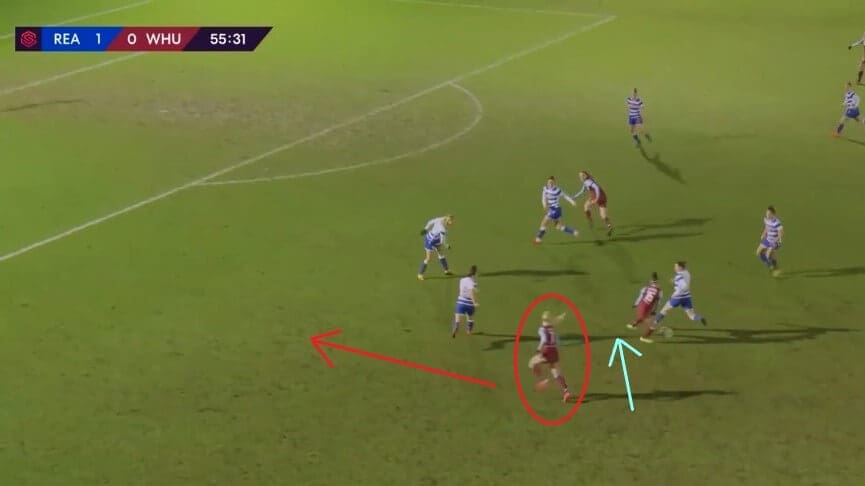
If we move the image on slightly, we come to this situation. Now, the player who Lehmann passed the ball to has taken it back inside, leaving the space on the wing open. However, because Lehmann has followed her pass, she occupies the space.
What this means is that, because the ball is now back in the congested area, Lehmann can move beyond it into the space behind the defence, as is being shown in this image. You can see also how another West Ham player in the middle has made a move forwards to offer a central passing option, and so with this double threat, West Ham have increased the possibility of them getting the ball into the box. If Lehmann hadn’t followed her pass and run forwards, then West Ham would likely have had to go backwards, or have had the ball taken off them.
Finally in this section, we will see how Lehmann creates space not for passing the ball into her, but to allow her teammates to take the ball into space themselves.

This image shows this point perfectly. In it, Lehmann is the furthest player forward for West Ham. She sees that her teammate, Kenza Dali, has the ball and is looking to come forward towards goal with it. Therefore, Lehmann creates the space for her by moving to the wing. As you can see from the red arrow, she therefore opens up the central channel for Dali to run into. This movement becomes even more significant because, as has been shown, the Liverpool defenders go with Lehmann, splitting the Liverpool defence, and meaning that the central route for Dali is now undefended, and she has a way through to goal.
Therefore, what we have seen in this section is how important Alisha Lehmann is in her team’s attack through creating spaces. We have seen how she makes movements to offer passing options, is constantly on the front foot, and takes defenders out of the way for her teammates.
Working with the front line
Now, we will turn our attention in this scout report to how Alisha Lehmann works with the West Ham front line during games.
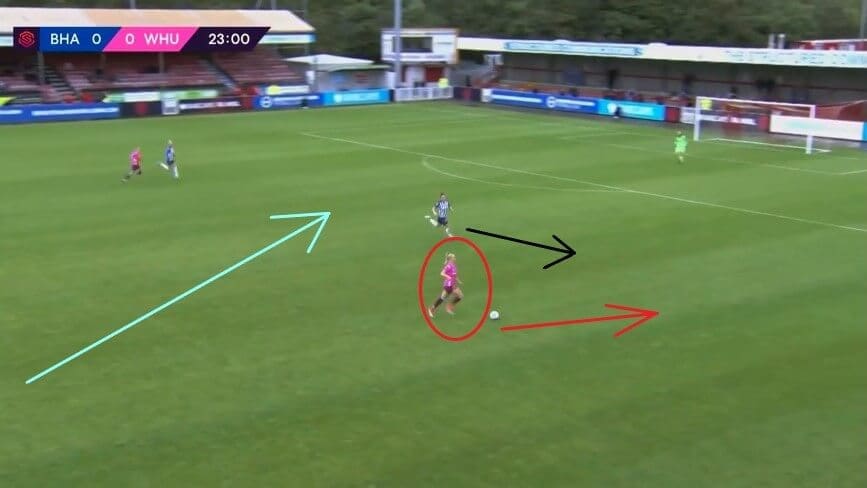
This image is similar to the last one in the previous section, although this time Lehmann is in possession of the ball. By taking it wide, as the red arrow shows, she looks to take the opposing Brighton and Hove Albion defender into the wide channel. In this example, that allows another West Ham attacker to come in and play through the space that has been created in the middle, as the arrow shows (this player is out of shot).
Lehmann works with the front line here to stretch the opposing defence. West Ham tend to play with a front three where they can, and here we can see how this works, with Lehmann taking the wide right position. This tends to be where she features most for West Ham. This is a theme we will now pick up.

Here, Lehmann is circled, virtually playing on the side line on the far side of the pitch. This means that the Liverpool defence is forced to stretch across the pitch, stopping her from running in behind. However, her aforementioned pace means that she is difficult to stop in these circumstances.
In this image, we see the effect of Lehmann playing in this wider position. Liverpool have all been drawn over to that side of the pitch, leaving the space open on the nearside for West Ham to attack into.
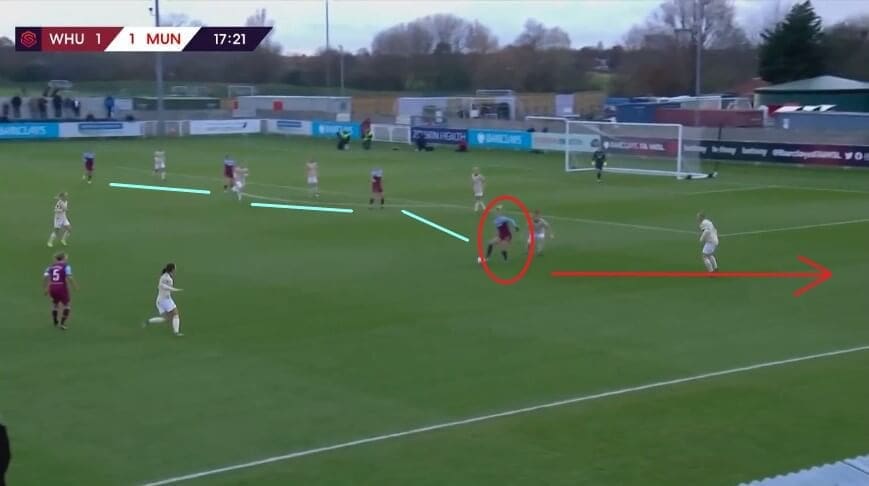
In this image, we see how Lehmann has taken up a position as part of West Ham’s front line. We can see how far apart West Ham have stretched the Manchester United defence, and Lehmann’s positioning is a part of this. You can see how gaps have appeared in the defence, and West Ham are positioning their attackers ready to move through them.
The main point about this is that Alisha Lehmann’s instinctive wide positioning ensures that her team centrally have space to work in. Her pace means she also provides a threat from the wide areas, increasing West Ham’s potency when attacking.
The second thing to mention about Lehmann working with the front line is when she knows to stay back, taking up a position behind the main attacker or attackers.

In this example, we see how West Ham are attacking, with the ball in the wide channel. However, because the box is congested, and the ball won’t reach Lehmann if she runs into it, the Swiss forward instead moves into a position just outside of the box, where she can receive the ball. This helps her team, because, whilst it means the ball has to come sideways, West Ham can keep the ball rather than running the risk of losing it. The gaps in the Liverpool defence also mean that, should Lehmann want to have a shot at goal from outside the box, she can, so this is another good reason for her to take up these positions.
Lastly, we see below how she can adapt her movements too.
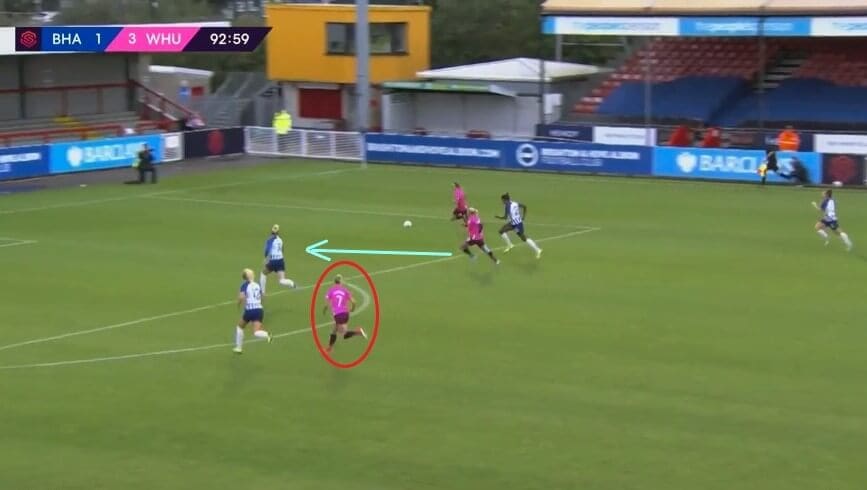
The ball is with the West Ham player on the far side of the box. You can see how there is one West Ham player running into the box to meet it when it is passed in, and Lehmann sees this. Therefore, she stays outside of the box, and becomes an attacking midfielder. Whilst she is therefore in front of the Brighton defenders, it means they have to watch her, meaning that her teammate has more space behind them to shoot from.
Secondly, it means that the player in possession in the image has two passing options, so if the Brighton defenders go with one player, she can pass to the other, and keep the move alive. Therefore, we can see how Lehmann’s ability to see where the space is, and adapt her runs accordingly, is important to her team’s tactical play.
Her versatility in attack
The final thing we need to look at as far as Alisha Lehmann’s role in West Ham’s tactics goes is her versatility in their attack, and her ability to play on either side of it, or down the middle.
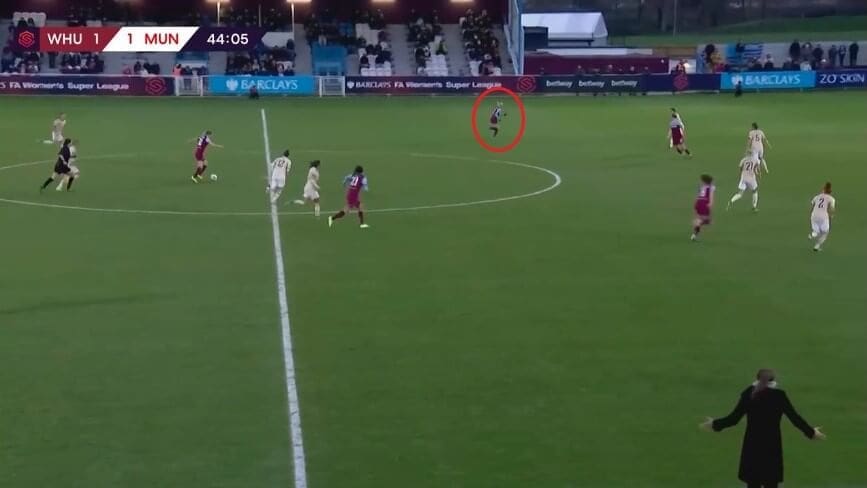
Beginning with her positioning in wider areas, we have already seen how she tends to play on the right-hand side of the attack. However, her pace and ability to run in behind means she can play on either wing. This gives West Ham more flexibility in their attacking setup, ensuring they carry a constant threat, and Lehmann is an important player in this. In the image, Manchester United Women have a narrow defensive structure, meaning that Lehmann’s wide positioning provides West Ham with a route to get the ball in behind the defence with little opposition.
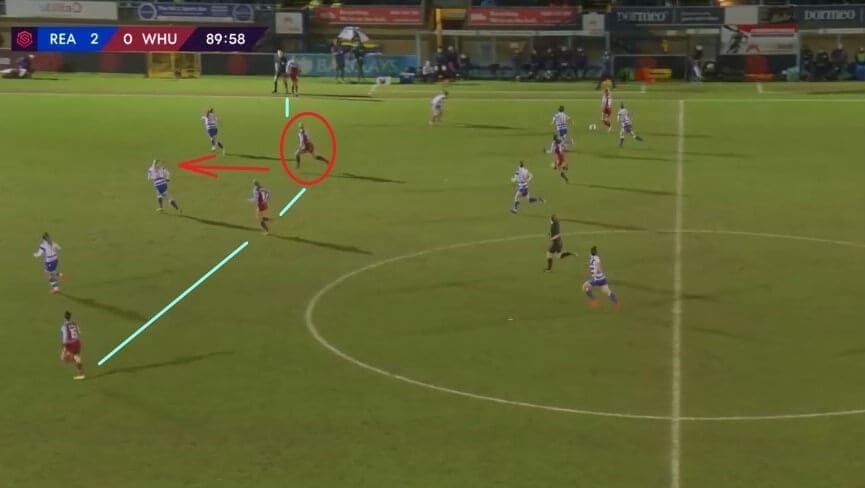
Here, we see how Lehmann has taken up a position as one of the two central attackers in the four-player forward line. In this position, she has seen where the space is, behind the Reading Women defence, and has looked to move into it, through the large gaps in the opposing defence. This is shown by the red arrow.
By moving into this space, she gets between the defenders, isolating each one, and she also allows her team to pass the ball over the defence, where her pace means she can run onto it. These are the two things that have come from her movement into this space, and we can see why having her in the team gives West Ham an added attacking presence.
As far as the versatility goes, we have seen how she can play centrally as well as on the wings, and have an effect on both her team’s and the opposition’s play in these areas too.
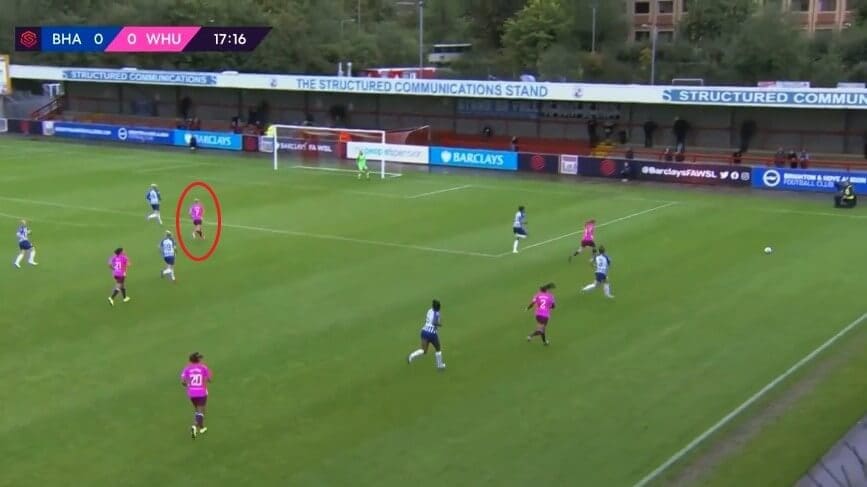
Here, the ball has moved into a wide position, and normally Lehmann, as the player on the right-hand side, would be the one looking to collect it and cross it in. However, because there are other West Ham players doing this, Lehmann instead moves centrally, aiming to offer the crossing option when the ball is collected by her teammate. You can see again how Brighton have left gaps in their defence, allowing Lehmann to run through into the position she is in now.
The long and the short of this section is that Lehmann can play in whichever role or position she needs to, and this is evident in the examples we have used. We see how her versatility creates space and passing options for her team as well, leading us back to the first section in this scout report.
Data analysis
We will now take a brief look at Alisha Lehmann’s stats for last season, to see if we can clearly identify her strengths and weaknesses.
As a forward, she will be expected to score and assist goals, and whilst her average goals per game of 0.22 doesn’t sound impressive, it matches her expected goals per game exactly, so she performs as predicted in this area. As for assists, she gets 0.15 per game, meaning that she does have an effect in some goals that her team scores. She also gets 45.8% of her shots on target, which means she provides a constant threat to opponents. Being on the right-hand side, normally, her crosses need to be accurate, but this only comes out at an average of 21.9% accuracy. Therefore, this is something she could look to improve on.
Moving on to her passes, she has an average passing accuracy of 67.7%; 50% accuracy on through passes; 61.9% accuracy on passes into the final third; 60.7% accuracy on forward passes; and 86.7% accuracy on backward passes. Therefore, what we can take from this is that her ability to find teammates with the ball is good, as all of these values are above or at 50%. However, there is still room for her to improve her passing accuracy to become an even better player.
Conclusion
In conclusion, we have analysed West Ham United Women forward Alisha Lehmann’s game in detail. We have identified that her strengths lie in her ability to create space, and to play in any position that her team needs her to play in. An area for improvement is that her crossing accuracy is low for a player who spends most of her time on the wing, and so this is something she can look to improve on for next season. However, at the age of 21 still, there is plenty of time for her to do this.





Comments